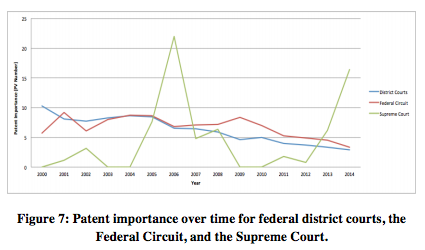Law professor develops big-data approach to patent value


LAWRENCE — Patents have long been used by inventors to protect their creations, but for just as long it has been exceedingly difficult to accurately determine the value of patents. Even today, to value a patent in a rigorous manner is expensive, requires the hiring of patent law and economics experts, and takes a long time.
A University of Kansas law professor and his University of Washington co-author have just published a study that offers a new and powerful method to evaluate patents, either individually or grouped together into gigantic portfolios. Their new approach, based on network and big-data analysis, can instantly determine which patents are the most important, whether overall, or by owner, inventor, attorney, patent examiner or technology. Doing so allows the authors to probe for answers to previously unanswerable questions about patent law, and their novel approach to “patent analytics” has the potential to open up a new area of legal study of patents, innovation, economics and policy.
 Andrew Torrance, the Earl B. Schurtz Research Professor at the KU School of Law, and Jevin West, a professor at the University of Washington Information School, have co-authored “All Patents Great and Small: A Big Data Network Approach to Valuation”, which was published March 27 in the University of Virginia Journal of Law and Technology. The article outlines the powerful methods of network analysis they used to explore and organize one of the biggest patent data sets ever compiled. Among their findings, they reveal that litigated patents tend to be much more valuable than those not litigated and that the value of litigated patents tends to rise strongly with the level of court in which litigation occurs. For example, patents litigated in federal district court (the lowest level) are, on average, more than five times more valuable than unlitigated patents, and patents that reach the U.S. Supreme Court are, on average, more than eight times more valuable.
Andrew Torrance, the Earl B. Schurtz Research Professor at the KU School of Law, and Jevin West, a professor at the University of Washington Information School, have co-authored “All Patents Great and Small: A Big Data Network Approach to Valuation”, which was published March 27 in the University of Virginia Journal of Law and Technology. The article outlines the powerful methods of network analysis they used to explore and organize one of the biggest patent data sets ever compiled. Among their findings, they reveal that litigated patents tend to be much more valuable than those not litigated and that the value of litigated patents tends to rise strongly with the level of court in which litigation occurs. For example, patents litigated in federal district court (the lowest level) are, on average, more than five times more valuable than unlitigated patents, and patents that reach the U.S. Supreme Court are, on average, more than eight times more valuable.
When Torrance and West plotted the average value of litigated patents on a map depicting all the federal judicial districts in the U.S., they discovered something surprising. Not only do the average values of litigated patents vary widely from district to district (Nevada and Connecticut host litigation of extremely valuable patents), they also noticed that the largest concentration of districts with litigated patents of especially high value, occurs in a “patent hotspot” in the southern central portion of the U.S., comprising Texas, Colorado, Kansas, Missouri and Arkansas. By contrast, the northern central U.S. districts tended to host litigations of low-value patents, forming a sort of “patent tundra.” Received wisdom would suggest that districts on the East and West coasts would see litigation of the most valuable patents, while the middle of the country would be “patent flyover country.” However, careful and powerful analysis of big patent data decisively refutes this assumption.
Torrance and West take advantage of huge sets of patent data made available by the United States Patent & Trademark Office. These data sets include detailed information about every U.S. patent issued from 1976 to the present. Determining patent value has been extremely difficult, given the complex nature of patent documents, the overwhelming amount of data and the traditional reliance on the opinions of patent “experts.” Instead, Torrance and West used algorithms developed to analyze vast amounts of data, including patent citation data.
“The mountain of data available on patents has become so large it’s just not possible for any individual, however brilliant, to understand, let alone master, it,” Torrance said. “What we’re doing could be called ‘big patent data analysis.’”
The approach not only can answer questions that were previously simply not answerable, it can help formulate new research questions. For example, few people would have thought to ask why valuable patents tend to be litigated in courts in Kansas and Colorado before the study, because it was widely assumed patents in the heartland were of low value. Now that the study has revealed the opposite to be true, Torrance and West intend to investigate what factors might explain the rich vein of patent gold that seems to run through federal courts in the south central region of the country.
Being able to judge the value of patents can have significant influence on the field of patent law. What has always been an expensive, slow, even artisanal process can now be done quickly, cheaply and efficiently, Torrance said, and can help patent holders, or anyone else interested in patent value, determine which ones are worth defending, which are not worth litigating, which ones to buy, sell or license and much more. Their analysis even sheds light on which inventors, law firms and patent examiners give rise to the most or least valuable patents.
“It could educate people on where the best places to litigate are. It may show we should change the laws on where it’s possible to litigate patents,” Torrance said of big-data patent analysis. “We’ve only looked at a limited set of questions so far, but the results of our first study encourage us to test a number of other basic assumptions in patent law, some of which may end up being unsupported. We think big patent data network analysis is a valuable way to probe those assumptions. It’s imperative to find out as much as we can about inventing and patenting so that we can better understand and foster innovation, which, we believe, is one of the best hopes for progress in the big issues facing humanity, like alleviating poverty, curing disease and protecting the environment.”
Interest in patent analytics and big patent data have recently reached a fever pitch. In March 2017 alone, Torrance was invited to share his expertise in the area at the University of Cambridge in the United Kingdom, the government of Canada, in Ottawa, Canada, and to the government of Ontario in Toronto, Canada. Other attendees included leading legal analytics companies, patent-holding corporations, the World Intellectual Property Organization, the Organization for Economic Cooperation and Development, and patent offices in Britain, Canada and the United States. He and West have also been invited by Cambridge University Press to contribute a chapter on patent analytics to a forthcoming book on legal analytics, and their study was recently listed on Social Science Research Network's top-10 download list for Intellectual Property: Empirical Studies eJournal.
A burgeoning field, data analytics in regard to law could open a new avenue of careers for aspiring lawyers and even change some of the skills deemed valuable in the law. The field has long been viewed as an art in which rhetorical and writing skills, for the purposes of producing strong, persuasive arguments, were considered the most valuable traits, Torrance said. But in the era of big data, complex algorithms and computer programming – the fundamentals for legal analytics – mathematical, scientific and computer science abilities are likely to rise in importance.
“There is a commonly held view that students who enter law school do so, in part, to avoid math,” Torrance said with a laugh. “But you cannot outrun math. It’s even finding its way into the law now. It was inevitable that mathematical analysis would eventually reach the law. Now it’s about to hit like a tidal wave. Math and science have always been required for patent law, so it’s no surprise that patent law is at the forefront of this trend. Patent law has always generated mountains of data, so it’s ripe for patent analytics. I think we’re going to find some very fascinating patterns in patent data, leading to the realization that we really don’t understand this area nearly as well as we thought we did. Big data and powerful analytic methods are throwing open the frontiers of patent law to a new generation of exploration. I can’t wait to be surprised by the findings that lie in wait for us. The level of interest in patent analytics and big patent data is exploding. We used to work on this research in the academic shadows, but suddenly a spotlight is shining on this area."